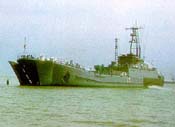Commentary / Admiral J G Nadkarni
India is caught in the vice-like jaws of the Graph of Absurdity
 India's defence budget has stagnated for the past six years. The marginal increase each year hardly takes care of even the inflationary
rise in revenue expenditure. No replacement equipment has been
ordered for a number of years. The air force is still waiting
for its jet trainer and the navy for its carrier.
India's defence budget has stagnated for the past six years. The marginal increase each year hardly takes care of even the inflationary
rise in revenue expenditure. No replacement equipment has been
ordered for a number of years. The air force is still waiting
for its jet trainer and the navy for its carrier.
So, what else is new? By now every schoolboy knows about the neglect
of defence by the Narasimha Rao government during its tenure.
What is not so well known is the other side of the coin. Even
if an indulgent government were to restore the defence budget to
its pristine days, the money will still purchase less than half
the tanks, aircraft and ships that it could buy in the eighties.
The high cost of defence has taken its toll. Developing and poor
countries are being priced out of the armaments market. Even the
affluent countries are finding it difficult to sustain their weapons
and arms industries.
Consider the following:
Following the end of the Cold War, the mightiest of the mighty,
United States has had to cut down its annual defence budget from
a high of about $ 320 billion to a more manageable $ 250 billion
now. What is more, the reduced outlay buys even less.
A nuclear
powered carrier comes in at $ 5 billion and the first of the
super sophisticated Seawolf submarines cost more than $ 1.5 billion.
Coming to terms with reality, the navy bosses have considerably
toned down their rhetoric. Only a few years ago they talked about
a 600 ship navy. Now the magic number is 300. The existing 13
carrier groups will gradually be reduced to 6.
In Europe, most of the countries have given up the ghost of
sustaining their armaments industries independently. Mergers and
joint projects are the order of the day. Two major manufacturers
of underwater weapons and detection equipment in Britain and
France joined recently to form a giant company.
Eurofighter, Eurocorvette
and Euromissile are the present catchwords. Three countries,
Britain, France and Italy, are jointly developing the next generation
frigate while a rival group comprising Germany, Spain and The
Netherlands is designing another. Two competing ASW helicopters,
the EH101 and NG 90, are both multinational projects.
In Britain, the Royal Navy is a shadow of its former self. A
force of over 200,000, not many years ago, has been pared down
to one fourth that size. After the takeover of the Vickers shipyard
by GEC-Marconi last year, the number of defence shipbuilders has
been reduced to two. In France too, the de Gaulle pride and rhetoric,
which saw the emergence of the Force de France and the seaborne
nuclear deterrent, has had to give way to a more pragmatic approach
to defence. France has recently had to stretch the
building of its first nuclear powered carrier.
In fact, the world over countries are beginning to face the rising
cost of developing and producing more and more sophisticated weapons.
Countries like India are already caught in the vice-like jaws of
the Graph of Absurdity. As a norm, defence expenditures normally
increase at about 3 to 5 per cent every year. On the other hand the
cost of producing weapons and equipment has been rising at between
10 to 15 per cent annually. The result is the inevitable squeeze.
At constant prices, if in 1970 one were able to buy 10 frigates
for a fixed defence budget, for the same amount (in percentage)
one can only purchase 5 in 1980 and 2 in 1990. By 2000 the same
navy will have to sell ships to remain afloat!
The last of the frigates bought from Britain in 1961 cost the
Indian government about Rs 90 million. Ten years later, the first
of the Leander class built in India, INS Nilgiri, cost Rs 180 million, a
rise of 100 per cent: By 1982, the first of the Godavari class
frigates was brought in at Rs 900 million, a fivefold increase. Costs are a closely
guarded secret, but the Delhi, due for delivery next year, will
reportedly cost the taxpayer upward of Rs 5 billion.
|





 India's defence budget has stagnated for the past six years. The marginal increase each year hardly takes care of even the inflationary
rise in revenue expenditure. No replacement equipment has been
ordered for a number of years. The air force is still waiting
for its jet trainer and the navy for its carrier.
India's defence budget has stagnated for the past six years. The marginal increase each year hardly takes care of even the inflationary
rise in revenue expenditure. No replacement equipment has been
ordered for a number of years. The air force is still waiting
for its jet trainer and the navy for its carrier.